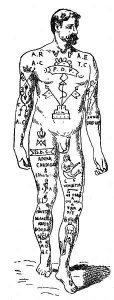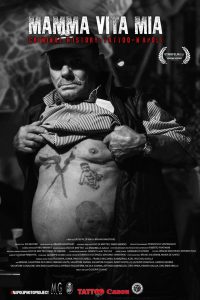The Code of the Camorra – Neapolitan mafioso ink
It is said never to judge a book by its cover. However, when it comes to the Camorra mobsters of Naples, you could probably judge them by the markings on their skin.
The tattooed syndicate of Naples 
Since modern times, Naples has always been one of the heaviest tattooed cities in the world. Its infamous mafia, the Camorra, is one of the oldest and bloodiest criminal organisations in Italy, dating back to the 17th century. The relationship between body art and the mafia go back to the early 19th century. Those working for the organised criminal syndicate would get their bodies permanently adorned with set motives. Both as a way of proving their lifelong loyalty, but also to indicate what function they filled, or where in the hierarchy of the organisation the belonged.
The ace of clubs was the motive used by Mafia underbosses to show that they were thugs who were good at… working with their hands. More sinister individuals would have guns inked somewhere on their bodies. This would indicate that they had taken one, or several, lives using this violent means. A knife would signify a lifelong oath in the form of a vendetta, a blood feud.

More subtle symbols, such as a small cross on a finger, would be used to signify hierarchical position within the organisation. Instant recognition, no calling card or Googling necessary. Eyes on the shoulders were also common as a means of saying that the mafia was always watching, even when you thought it couldn’t see.
Skin-deep absolution
Often, violent motives would be intertwined with religious symbolism, such as rosaries, or flaming hearts adorned with a crown of thorns. These symbols were supposed to help their owners get away with the violent crimes the other imagery identified him as taking part in. The Camorra did not much separate the sacred and the profane… Often there would also be skulls and other symbols relating to an awareness of mortality, or rather, the desire to cheat death for as long as possible.
Family and Bodo the Boss
During a famous feud in the Neapolitan quartiere of Scampia 2004-2005, tattoos were used as a means of appeal. Members of the warring gangs of the Di Lauro clan and those who called themselves the ‘secessionists’ would have ‘Do not touch my family’ written on their forearms. A request to spare the loved ones of the mobsters, at a time when enemies would stop at nothing to get to each other.
Recently, the police have arrested several young members from a clan in a suburb called Ponticelli. They have become known as ‘the tattooed ones’ because of all having had the name of their boss, Bodo, inked on their forearms and backs. Some of them have also added the phrase ‘Respect, loyalty, honour.’
Mother Life of Mine

The makers of a documentary called ‘Mamma Vita Mia’ gained exclusive access into the homes and the tattooed histories of Camorra former bosses. For the first time the stories of their ink was told by the canvases themselves. The film premiered at the London Tattoo Convention in 2018, and takes its name from the most widespread tattoo of all, ‘M.V.M.’ (translates to ‘Mother Life of Mine’). It goes on to show the evolution of tattooing in the city, and the shifting relationship of its youth to the art form. In spite of its newfound mainstream popularity, maybe no one is rushing to get an ace of clubs or a knife inked as a motive just yet…
